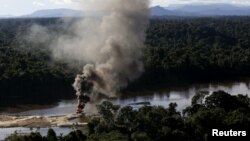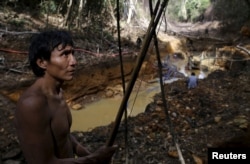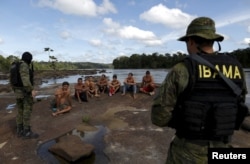Brazilian environmental special forces burst into a clearing where the trees had been sawn and a muddy crater dug: an illegal gold mine on indigenous land in the heart of the Amazon.
The miners and gold were already gone, scattered by the whir of helicopter blades, but armed troopers in camouflage burned tents and generators. When there was nothing left, they moved on to the next.
The five-day operation in April, led by Brazil's environmental agency Ibama and Indian foundation Funai, located 15 airstrips and destroyed 20 barges used to transport equipment and supplies by the estimated 5,000 illegal miners in the vast remote region.
At more than 23.5 million acres (9.5 million hectares), the Yanomami people's territory is twice the size of Switzerland and home to around 27,000 indigenous people.
The land has legally belonged to the Yanomami since 1992, but miners continue to exploit the area, sawing down trees and poisoning rivers with mercury in their lust for gold.
The mercury has become a growing cause for concern. While miners once killed the Yanomami with guns or disease - nearly 20 percent of the population was wiped out in the 1980s - today the threat is the toxic liquid metal used to separate gold from grit.
A study published in March by the Oswaldo Cruz Foundation, a public biomedical research group, found that in some Yanomami villages, 92 percent of residents suffered from mercury poisoning. The results shocked experts, who believe mercury is entering the food chain through fish in polluted rivers.
High mercury exposure harms the nervous, digestive and immune systems, can lead to impaired vision and hearing, and can be fatal.
The April raid was considered a success but Ibama's operation leader Roberto Cabral said the miners will probably be back.
"The aim is to destroy their equipment. We're not able to arrest them, there's no space in the helicopter," he said, sweat pouring down his face in the middle of the steamy jungle.
When miners were caught, they were grilled for information and released. Beyond the equipment, authorities have been hunting for clues on the illicit business interests behind the miners.
The region's remoteness is a constant challenge.
From a base in the Tepequém mountains on the frontier with Venezuela, three helicopters flew the 35-person team for an hour-and-a-half to the banks of the majestic Uraricoera river.
From there it was another hour or two on foot, cutting aside branches and wading through waist-high mud, to reach the mines.
It is expensive and rare for the arm of the law to reach this far.
It might become rarer still. With Brazil suffering through its worst recession in a century, Funai's budget for 2016 was cut by 24 percent, while Ibama had its spending reduced by 30 percent.
For Fiona Watson, who works for the activist group Survival International and has campaigned for the Yanomami since 1990, any long-term solution must be based on having more people on the ground, graver punishments and a focus on those hiring the miners and supplying equipment.
"These miners are like ants," Watson said. "They just keep coming back."


